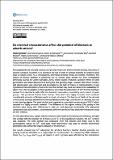Por favor, use este identificador para citar o enlazar a este item:
http://hdl.handle.net/10261/229414COMPARTIR / EXPORTAR:
 SHARE
BASE SHARE
BASE
|
|
| Visualizar otros formatos: MARC | Dublin Core | RDF | ORE | MODS | METS | DIDL | DATACITE | |

| Título: | Do chemical characteristics affect the potential of biochars to adsorb cations? |
Autor: | Knicker, Heike CSIC ORCID ; García Castro de Barragán, J. M.; Fernández Boy, E.; Knicker, Michael; León Ovelar, Regina; Velasco Molina, Marta CSIC ORCID | Fecha de publicación: | 5-may-2020 | Editor: | European Geosciences Union | Citación: | Knicker, H., Garcia Castro de Barragan, J. M., Elena Fernandez-Boy, E., Knicker, M., León-Ovelar, R., and Velasco-Molina, M.: Do chemical characteristics affect the potential of biochars to adsorb cations?, EGU General Assembly 2020, Online, 4–8 May 2020, EGU2020-3075, https://doi.org/10.5194/egusphere-egu2020-3075, 2020 | Resumen: | Since peatlands are valuable habitats and provide important environmental services, the policy of several European countries is to decrease the use of peat in potting mixtures to preserve peat bogs as nature areas. As a consequence, alternative growing media are needed. Therefore, the impact of biochar addition to gardening soil on tomato plant growth has been investigated previously (García de Castro Barragán, 2018). Those studies revealed a positive effect on seed germination and plant development during the first growing stage. However after three months, leaf discoloration was observed and associated to the lack of macro or micronutrients. It was hypothized that adsorption of nutrients onto the biochar may have decreased their availability for plants. For a first evaluation of this hypothesis, we tested the adsorption of Cu2+ to three biochars derived from feedstocks with different chemical composition, aromaticity and content of polar groups. We produced biochar from shrimp chitin which was highly aromatic and contained considerable amounts of N-heterocyclic aromatic structures. The biochar of shells of the oil seed of Acrocomia aculeata derived from a woody feedstock with high contribution of cellulose, but had a low charring degree. The peat biochar was prepared at a pyrolysis temperature of 500°C which resulted in a highly aromatic material. The difference in the organic matter (OM) quality of the biochars went along with differences in their pH and electrical conductivity (EC); elemental composition and ash content. Concomitantly, different specific surface areas were measured using the BET method. | Descripción: | Pdf de la presentación de 26 diapositivas de la presentación de la conferencia dada en la EGU General Assembly 2020, Online, 4–8 May 2020 | Versión del editor: | http://dx.doi.org/10.5194/egusphere-egu2020-3075 | URI: | http://hdl.handle.net/10261/229414 | DOI: | 10.5194/egusphere-egu2020-3075 | Identificadores: | doi: 10.5194/egusphere-egu2020-3075 |
| Aparece en las colecciones: | (IRNAS) Comunicaciones congresos |
Ficheros en este ítem:
| Fichero | Descripción | Tamaño | Formato | |
|---|---|---|---|---|
| EGU2020-3075_presentation.pdf | 2,27 MB | Adobe PDF |  Visualizar/Abrir | |
| Abstract EGU2020 id.3075.pdf | 293,6 kB | Adobe PDF |  Visualizar/Abrir |
CORE Recommender
Page view(s)
117
checked on 01-may-2024
Download(s)
200
checked on 01-may-2024
Google ScholarTM
Check
Altmetric
Altmetric
NOTA: Los ítems de Digital.CSIC están protegidos por copyright, con todos los derechos reservados, a menos que se indique lo contrario.
